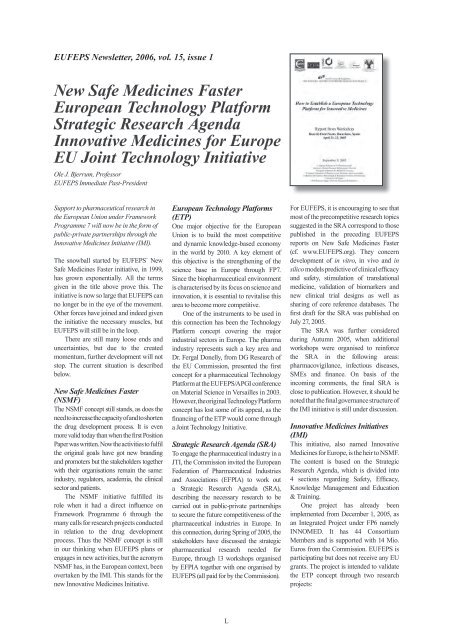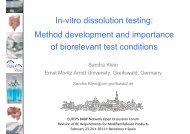2011 Anniversary Yearbook - EUFEPS today and history
2011 Anniversary Yearbook - EUFEPS today and history
2011 Anniversary Yearbook - EUFEPS today and history
Create successful ePaper yourself
Turn your PDF publications into a flip-book with our unique Google optimized e-Paper software.
<strong>EUFEPS</strong> Newsletter, 2006, vol. 15, issue 1<br />
New Safe Medicines Faster<br />
European Technology Platform<br />
Strategic Research Agenda<br />
Innovative Medicines for Europe<br />
EU Joint Technology Initiative<br />
Ole J. Bjerrum, Professor<br />
<strong>EUFEPS</strong> Immediate Past-President<br />
Support to pharmaceutical research in<br />
the European Union under Framework<br />
Programme 7 will now be in the form of<br />
public-private partnerships through the<br />
Innovative Medicines Initiative (IMI).<br />
The snowball started by <strong>EUFEPS</strong>´ New<br />
Safe Medicines Faster initiative, in 1999,<br />
has grown exponentially. All the terms<br />
given in the title above prove this. The<br />
initiative is now so large that <strong>EUFEPS</strong> can<br />
no longer be in the eye of the movement.<br />
Other forces have joined <strong>and</strong> indeed given<br />
the initiative the necessary muscles, but<br />
<strong>EUFEPS</strong> will still be in the loop.<br />
There are still many loose ends <strong>and</strong><br />
uncertainties, but due to the created<br />
momentum, further development will not<br />
stop. The current situation is described<br />
below.<br />
New Safe Medicines Faster<br />
(NSMF)<br />
The NSMF concept still st<strong>and</strong>s, as does the<br />
need to increase the capacity of <strong>and</strong> to shorten<br />
the drug development process. It is even<br />
more valid <strong>today</strong> than when the first Position<br />
Paper was written. Now the activities to fulfil<br />
the original goals have got new br<strong>and</strong>ing<br />
<strong>and</strong> promoters but the stakeholders together<br />
with their organisations remain the same:<br />
industry, regulators, academia, the clinical<br />
sector <strong>and</strong> patients.<br />
The NSMF initiative fulfilled its<br />
role when it had a direct influence on<br />
Framework Programme 6 through the<br />
many calls for research projects conducted<br />
in relation to the drug development<br />
process. Thus the NSMF concept is still<br />
in our thinking when <strong>EUFEPS</strong> plans or<br />
engages in new activities, but the acronym<br />
NSMF has, in the European context, been<br />
overtaken by the IMI. This st<strong>and</strong>s for the<br />
new Innovative Medicines Initiative.<br />
European Technology Platforms<br />
(ETP)<br />
One major objective for the European<br />
Union is to build the most competitive<br />
<strong>and</strong> dynamic knowledge-based economy<br />
in the world by 2010. A key element of<br />
this objective is the strengthening of the<br />
science base in Europe through FP7.<br />
Since the biopharmaceutical environment<br />
is characterised by its focus on science <strong>and</strong><br />
innovation, it is essential to revitalise this<br />
area to become more competitive.<br />
One of the instruments to be used in<br />
this connection has been the Technology<br />
Platform concept covering the major<br />
industrial sectors in Europe. The pharma<br />
industry represents such a key area <strong>and</strong><br />
Dr. Fergal Donelly, from DG Research of<br />
the EU Commission, presented the first<br />
concept for a pharmaceutical Technology<br />
Platform at the <strong>EUFEPS</strong>/APGI conference<br />
on Material Science in Versailles in 2003.<br />
However, the original Technology Platform<br />
concept has lost some of its appeal, as the<br />
financing of the ETP would come through<br />
a Joint Technology Initiative.<br />
Strategic Research Agenda (SRA)<br />
To engage the pharmaceutical industry in a<br />
JTI, the Commission invited the European<br />
Federation of Pharmaceutical Industries<br />
<strong>and</strong> Associations (EFPIA) to work out<br />
a Strategic Research Agenda (SRA),<br />
describing the necessary research to be<br />
carried out in public-private partnerships<br />
to secure the future competitiveness of the<br />
pharmaceutical industries in Europe. In<br />
this connection, during Spring of 2005, the<br />
stakeholders have discussed the strategic<br />
pharmaceutical research needed for<br />
Europe, through 13 workshops organised<br />
by EFPIA together with one organised by<br />
<strong>EUFEPS</strong> (all paid for by the Commission).<br />
L<br />
For <strong>EUFEPS</strong>, it is encouraging to see that<br />
most of the precompetitive research topics<br />
suggested in the SRA correspond to those<br />
published in the preceding <strong>EUFEPS</strong><br />
reports on New Safe Medicines Faster<br />
(cf. www.<strong>EUFEPS</strong>.org). They concern<br />
development of in vitro, in vivo <strong>and</strong> in<br />
silico models predictive of clinical efficacy<br />
<strong>and</strong> safety, stimulation of translational<br />
medicine, validation of biomarkers <strong>and</strong><br />
new clinical trial designs as well as<br />
sharing of core reference databases. The<br />
first draft for the SRA was published on<br />
July 27, 2005.<br />
The SRA was further considered<br />
during Autumn 2005, when additional<br />
workshops were organised to reinforce<br />
the SRA in the following areas:<br />
pharmacovigilance, infectious diseases,<br />
SMEs <strong>and</strong> finance. On basis of the<br />
incoming comments, the final SRA is<br />
close to publication. However, it should be<br />
noted that the final governance structure of<br />
the IMI initiative is still under discussion.<br />
Innovative Medicines Initiatives<br />
(IMI)<br />
This initiative, also named Innovative<br />
Medicines for Europe, is the heir to NSMF.<br />
The content is based on the Strategic<br />
Research Agenda, which is divided into<br />
4 sections regarding Safety, Efficacy,<br />
Knowledge Management <strong>and</strong> Education<br />
& Training.<br />
One project has already been<br />
implemented from December 1, 2005, as<br />
an Integrated Project under FP6 namely<br />
INNOMED. It has 44 Consortium<br />
Members <strong>and</strong> is supported with 14 Mio.<br />
Euros from the Commission. <strong>EUFEPS</strong> is<br />
participating but does not receive any EU<br />
grants. The project is intended to validate<br />
the ETP concept through two research<br />
projects:




